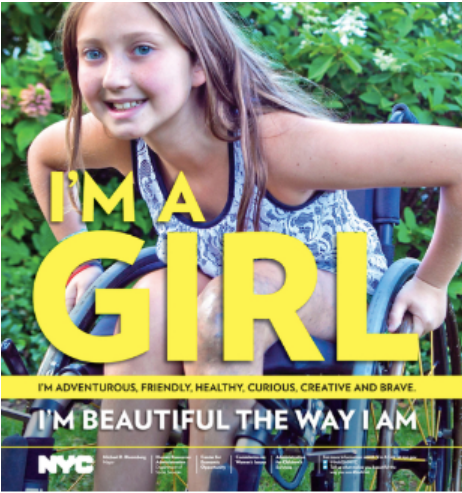
In October 2013, New York City launched the "I’m A Girl"campaign, making New York the first major city in the nation to tackle the issue of girls' body image and self-esteem.
Created and directed by Samantha Levine, the Campaign, which included a $250,000 public education campaign, supportive school curriculum as well as sports and volunteer components, was designed to help girls believe their value comes from their character, skills, relationships and attributes - not appearance - while also expanding the definition of beautiful beyond an unhealthy, unrealistic ideal. The New York Times covered the campaign with an exclusive feature.
Running for two-months on subways, buses, phone kiosks, and bus shelters, the focus-grouped poster campaign featured 21 girls between the ages of 5 and 13 of varying races, ethnicities, sizes, and abilities - one girl was in a wheelchair - glasses and braces. Knowing that girls as young as seven and eight were starting to diet and find fault with their bodies, the campaign targeted girls 7-12 to make sure that, as they began confronting the messages the media and society sent, they were also surrounded by positive messages and representations of happy, confident girls who looked like them.
At the same time, to reach older girls (10-16), the City's Department of Youth and Community Development piloted self-esteem programming for more than 75 after-school programs and half a dozen schools. Additionally, the City's Parks Department targeted programming, including free fitness program classes in all five boroughs, especially for girls ages 8 to 13 years old, along with all- girl teams in the City's flag football league.
In the weeks following the launch, the public responded enthusiastically, with hundreds asking how to bring it to their city, state or country. Requests ranged from: Atlanta, GA; Baltimore, MD; Buffalo, NY; Decatur, GA; Denver, CO; Kentucky; Michigan; Nebraska; New Hampshire; North Carolina; Oregon; Pennsylvania; Rhode Island; Tallahassee, FL; Texas; Virginia; Washington, DC; Australia; Paris; and Portugal.
The campaign generated 400 million impressions and received media coverage in the New York Times, Elle, Cosmopolitan, Think Progress, Time, NY1, WABC, Fox5, Globo, Brian Lehrer.
Washington, D.C. Campaign
Subsequent to the New York project, Samantha worked with the City of Washington DC to produce and execute a second generation campaign, which included two months of posters - specifically designed using DC girls and resources - on the DC metro. The campaign generated 40 million impressions.







